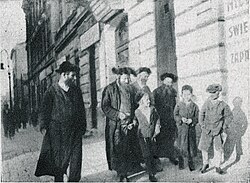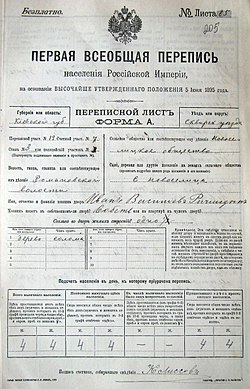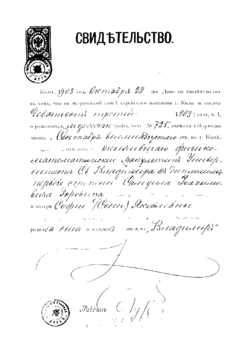
The history of the Jews in Ukraine dates back over a thousand years, with Jewish communities existing in the modern territory of Ukraine since the time of the Kievan Rus' (late 9th to mid-13th century). During the Middle Ages, Ashkenazi Jews lived in the territory of modern-day Germany, the Czech Republic, France, and northern Italy. In the 13th century, Jewish communities emerged in Poland, and their active growth began in the 14th century, when Polish King Casimir III supported Jews who were persecuted throughout Europe. Later, in the 16th and 17th centuries, Polish magnates who were settling vast territories in modern-day Ukraine and Belarus invited Jews from Central Europe to their estates to accelerate the economic development of these regions. Jews mainly settled in privately owned towns, which were given a special name in Polish – "miejsce" (meaning "a small town"), and in Yiddish – "shtetl". See the list of Jewish shtetls in Ukraine here.
After the partitions of the Polish-Lithuanian Commonwealth (1772-1795), a significant part of these lands became part of the Russian Empire, and Polish and Lithuanian Jews became Russian subjects. In 1791, the territory of Jewish permanent residence was limited by the Pale of Settlement, which included the annexed Polish territories, as well as Novorossiya, Crimea, and parts of central and eastern Ukraine (Poltava, Ekaterinoslav, Chernigov, and Kiev provinces). However, even in some cities within the Pale of Settlement, Jews were prohibited from settling, such as in Kiev and Nikolaev.[1]
The history of the Jews in Ukraine is marked by periods of violence and persecution, which make genealogical research a complicated process. In the mid to late 1800s, a wave of large-scale anti-Jewish violence known as pogroms swept through the southern Russian Empire, including Ukraine, following the assassination of Alexander II in 1881. These pogroms led to the deaths of thousands of Jews.
During the Russian Revolution and ensuing Civil War, an estimated 31,071 Jews were killed between 1918 and 1920. Pogroms continued to be perpetrated on Ukrainian territory during the establishment of the Ukrainian People's Republic (1917-21), leading to the deaths of between thirty-five and fifty thousand civilian Jews. Massive pogroms continued until 1921.
In September 1939, the first Jews living in the western regions under Nazi control were forced into ghettos and later sent to death camps. This continued throughout the remainder of the war. By June 1941, the territory of modern-day Ukraine was home to the largest number of Jews in Europe and the second-largest in the world, after the United States, with an estimated 2.7-2.8 million Jews.
During World War II, approximately 900,000 people lost their lives in Ukraine. By 1959, the Jewish population in Ukraine numbered 840,000. This number decreased to 787,000 in 1989, and as of 2014, there were approximately 400,000 Jews living in Ukraine.[2]
Research your ancestors on MyHeritage
Difficulties of genealogical research in UkraineDifficulties of genealogical research in Ukraine

Migration, pogroms, Soviet repression, the Holocaust, and then again repression seriously complicate the search for roots for the descendants of Ukrainian Jews. During the German occupation, not only did millions of Jews die, but archives were burned, Jewish cemeteries were destroyed, and whole families were wiped out. The Soviet government was not very interested in preserving the memory of Jews, and the digitalization of archives in recent decades has not been as fast as desired. After Russia's invasion of Ukraine in 2022, non-digitized documents were once again under threat of destruction.
Furthermore, even searching through surviving documents is complicated by several factors, including the carelessness of Russian officials who worked on the Russian Empire Population Census; language (many archival documents are written in Russian or Hebrew, which are not translated into English); the fact that residents of shtetls rarely kept memories of their ancestors and compiled a family tree; and the fact that during forced censuses, surnames were randomly assigned, often based on the name of the nearest large city to the shtetl. There was also a tendency to hide boys from conscription by recording them under a false name and concealing their identity. Endogamy (consanguineous marriages) further complicates genealogical research, even through DNA analysis. All these factors make researching Jewish genealogy in the former Russian empire a complicated process.
Research StepsResearch Steps
Surname researchSurname research
Beginning genealogical research is best done by exploring the origin of one's ancestors' Ukrainian Jewish surnames. A surname can help determine the place of residence, occupation, and social status, and track family relationships within the lineage.
Locate the ancestral place of residenceLocate the ancestral place of residence
To begin tracing the family history, it's crucial to first determine the name of the ancestral town. It's also beneficial to identify the province where the town is located, which can be done by referring to historical atlases and web-search. Then there’s a chance of finding data in local archives or to limit the web-search.
Vital recordsVital records

Vital records refer to the official records of life events such as births, marriages, and deaths. In the Russian Empire, these records were maintained by the Jewish community and became compulsory from 1835 onwards. The records were written in a tabular format in both Russian and Hebrew. Additionally, several censuses, known as "Revision Lists," were conducted during the 18th and 19th centuries, with a comprehensive all-Empire census in 1897. These censuses are currently preserved and can be accessed for genealogical research purposes.
List of casualties in wars, the Holocaust, and during the Stalinist repressionsList of casualties in wars, the Holocaust, and during the Stalinist repressions
To restore lost links in the genealogical chain, it is necessary to refer to archives containing information on those who died or went missing during the First and Second World Wars, lists of Holocaust victims, as well as data on those who died or went missing during the Soviet repressions.
See alsoSee also
Explore more on Ukrainian Jewish genealogyExplore more on Ukrainian Jewish genealogy
- Jewish birth records, Ukraine at MyHeritage
- Jewish death records, Ukraine at My Heritage
- Bessarabia, Jewish Births from JewishGen on MyHeritage
- Bessarabia, Jewish Marriages from JewishGen on MyHeritage
- Bessarabia, Jewish Deaths from JewishGen on MyHeritage
- Sub-Carpathia, Jewish Birth Records from JewishGen on MyHeritage
- Ukraine, Revision Lists from JewishGen on MyHeritage
- Ukraine, Odessa Birth Records from JewishGen on MyHeritage
- How to Research Your Jewish Ancestors on MyHeritage at MyHeritage Knowledge Base
- Communities Database at JewishGen
- Family Finder at JewishGen
- Historical maps of Ukraine at The Miriam Weiner Routs to Roots Foundation
- The Central Database of Shoah victims' names at Yad Vashem
- Stalin's execution lists at stalin.memo.ru

